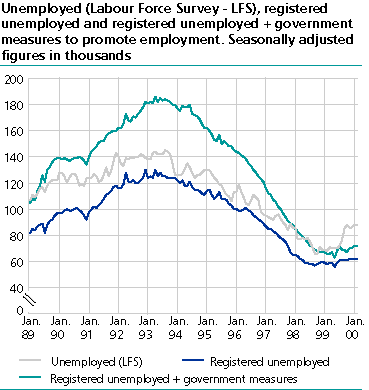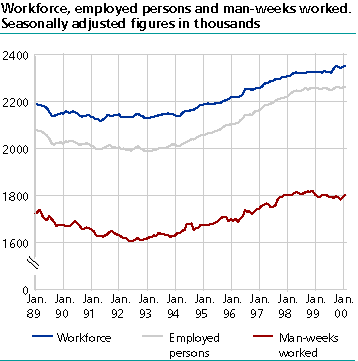Content
Published:
This is an archived release.
Higher unemployment
91 000 persons where unemployed in first quarter 2000, 21 000 more than in the same quarter last year. Seasonally adjusted figures indicate some increase in unemployment from fourth quarter 1999 to first quarter 2000, after rise also through the two previous quarters.
Higher level of unemployment
91 000 persons where unemployed in first quarter 2000, accounting for 3.9 per cent of the workforce. According to the seasonally adjusted figures the unemployment reached the lowest level in autumn 1998 and started to rise through the last six months of 1999. The figures show that the unemployment rate at present is on a distinct higher level than one year ago.
Strong growth among men
From first quarter 1999 to first quarter this year the unemployment has risen in all age groups among both men and women. Unemployment increased from 2.9 to 3,3 per cent among women and from 3,2 to 4,4 among men. Men 25-54 years of age had the sharpest rise in unemployment with 43 per cent.
The number of long-term unemployed increased by 4 000 last year. Long-term unemployed are those who at the time of the survey had been continuously unemployed for more than a half year. The rate rose from 16 to 17 per cent.
There were 68 000 underemployed in the first quarter, i.e. part-time employed seeking more work. This is 4 000 less than in the same quarter the previous year. As a percentage of part-time employed, this corresponds to a drop from 10.8 to 10.2 per cent.
Around 73.0 per cent of the population aged 16-74 were either employed or unemployed in first quarter 2000, as opposed to 72.6 per cent a year before. The labour force participation rate increased by 0.4 per cent for both women and men. There was a strong surge in labour force participation in the age group 16-19.
Compared to first quarter 1999, there was an increase in employment within public administration, education, health and social services as well as retail trade. Manufacturing and transport, on the other hand, showed a decline in employment.
Growth in man-weeks worked
Statistics Norway has estimated an increase of 17 000 man-weeks worked (0.9 per cent), but the figures are uncertain, partly because of different placing of Easter in those two years and partly because the percentage of people on holiday leave during part of the reference week may have differed in the two years. This has resulted in a break in the time series for man-weeks worked and for absence.
Fewer temporary employed
There were 187 000 temporary employed in the first quarter this year, 18 000 less than in the same quarter last year. The rate of temporary employment was relatively highest in the hotel and restaurant industry, education and health and social services. Agriculture, forestry and fishing industries and transport and communication industry represented the greatest decline. However, retail trade and hotel and restaurant industry showed a increase.
Decline in sickness absence among women
Around 91 000 employed people were temporarily absent due to sickness the entire survey week in the first quarter. The illness-related absence rate for women was 4,6 per cent and 3,6 per cent for men. Adjusted for the break in the time series, the sickness absence last year is estimated to be unchanged, but with a 0.3 percentage-point increase for men and a 0.4 percentage-point drop for women.
Seasonally adjusted figures
Quality tests show that the seasonally adjusted LFS unemployment figures are uncertain. The seasonal-adjustment method has problems identifying a seasonal pattern in this series of figures. The random results are relatively large compared to the seasonal component, hence one must keep in mind that the unemployment figures contain a particularly high degree of uncertainty. Statistics Norway plans to publish seasonally adjusted LFS figures based on the observed seasonal pattern after the readjustment in 1996.
Statistics are published quarterly.
Contact
-
Arbeidsmarked og lønn
E-mail: arbeidsmarked@ssb.no
-
Erik Herstad Horgen
E-mail: erik.horgen@ssb.no
tel.: (+47) 93 08 68 62
-
Håvard Hungnes Lien
E-mail: havard.lien@ssb.no
tel.: (+47) 40 90 26 06


